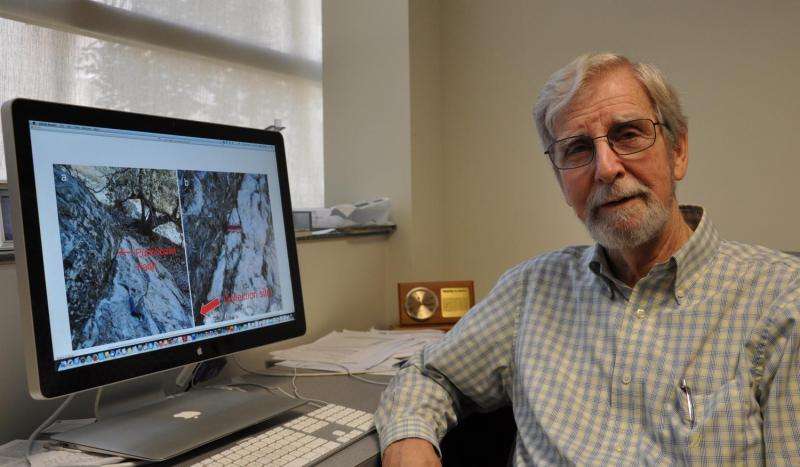Study proposes common mechanism for shallow and deep earthquakes

Earthquakes are labeled "shallow" if they occur at less than 50 kilometers depth. They are labeled "deep" if they occur at 300-700 kilometers depth. When slippage occurs during these earthquakes, the faults weaken. How this fault weakening takes place is central to understanding earthquake sliding.
A new study published online in Nature Geoscience today by a research team led by University of California, Riverside geologists now reports that a universal sliding mechanism operates for earthquakes of all depths—from the deep ones all the way up to the crustal ones.
"Although shallow earthquakes—the kind that threaten California—must initiate differently from the very deep ones, our new work shows that, once started, they both slide by the same physics," said deep-earthquake expert Harry W. Green II, a distinguished professor of the Graduate Division in UC Riverside's Department of Earth Sciences, who led the research project. "Our research paper presents a new, unifying model of how earthquakes work. Our results provide a more accurate understanding of what happens during earthquake sliding that can lead to better computer models and could lead to better predictions of seismic shaking danger."
The physics of the sliding is the self-lubrication of the earthquake fault by flow of a new material consisting of tiny new crystals, the study reports. Both shallow earthquakes and deep ones involve phase transformations of rocks that produce tiny crystals of new phases on which sliding occurs.
"Other researchers have suggested that fluids are present in the fault zones or generated there," Green said. "Our study shows fluids are not necessary for fault weakening. As earthquakes get started, local extreme heating takes place in the fault zone. The result of that heating in shallow earthquakes is to initiate reactions like the ones that take place in deep earthquakes so they both end up lubricated in the same way."
Green explained that at 300-700 kilometers depth, the pressure and temperature are so high that rocks in this deep interior of the planet cannot break by the brittle processes seen on Earth's surface. In the case of shallow earthquakes, stresses on the fault increase slowly in response to slow movement of tectonic plates, with sliding beginning when these stresses exceed static friction. While deep earthquakes also get started in response to increasing stresses, the rocks there flow rather than break, except under special conditions.
"Those special conditions of temperature and pressure induce minerals in the rock to break down to other minerals, and in the process of this phase transformation a fault can form and suddenly move, radiating the shaking—just like at shallow depths," Green said.
The research explains why large faults like the San Andreas Fault in California do not have a heat-flow anomaly around them. Were shallow earthquakes to slide by the grinding and crunching of rock, as geologists once imagined, the process would generate enough heat so that major faults like the San Andreas would be a little warmer along their length than they would be otherwise.
"But such a predicted warm region along such faults has never been found," Green said. "The logical conclusion is that the fault must move more easily than we thought. Extreme heating in a very thin zone along the fault produces the very weak lubricant. The volume of material that is heated is very small and survives for a very short time—seconds, perhaps - followed by very little heat generation during sliding because the lubricant is very weak."
The new research also explains why faults with glass on them (reflecting the fact that during the earthquake the fault zone melted) are rare. As shallow earthquakes start, the temperature rises locally until it is hot enough to start a chemical reaction—usually the breakdown of clays or carbonates or other hydrous phases in the fault zone. The reactions that break down the clays or carbonates stop the temperature from climbing higher, with heat being used up in the reactions that produce the nanocrystalline lubricant.
If the fault zone does not have hydrous phases or carbonates, the sudden heating that begins when sliding starts raises the local temperature on the fault all the way to the melting temperature of the rock. In such cases, the melt behaves like a lubricant and the sliding surface ends up covered with melt (that would quench to a glass) instead of the nanocrystalline lubricant.
"The reason this does not happen often, that is, the reason we do not see lots of faults with glass on them, is that the Earth's crust is made up to a large degree of hydrous and carbonate phases, and even the rocks that don't have such phases usually have feldspars that get crushed up in the fault zone," Green explained. "The feldspars will 'rot' to clays during the hundred years or so between earthquakes as water moves along the fault zone. In that case, when the next earthquake comes, the fault zone is ready with clays and other phases that can break down, and the process repeats itself."
The research involved the study of laboratory earthquakes—high-pressure earthquakes as well as high-speed ones—using electron microscopy in friction and faulting experiments. It was Green's laboratory that first conducted a serendipitous series of experiments, in 1989, on the right kind of mantle rocks that give geologists insight into how deep earthquakes work. In the new work, Green and his team also investigated the Punchbowl Fault, an ancestral branch of the San Andreas Fault that has been exhumed by erosion from several kilometers depth, and found nanometric materials within the fault—as predicted by their model.
More information: Phase transformation and nanometric flow cause extreme weakening during fault slip, Nature Geoscience, DOI: 10.1038/ngeo2436
Journal information: Nature Geoscience
Provided by University of California - Riverside



















